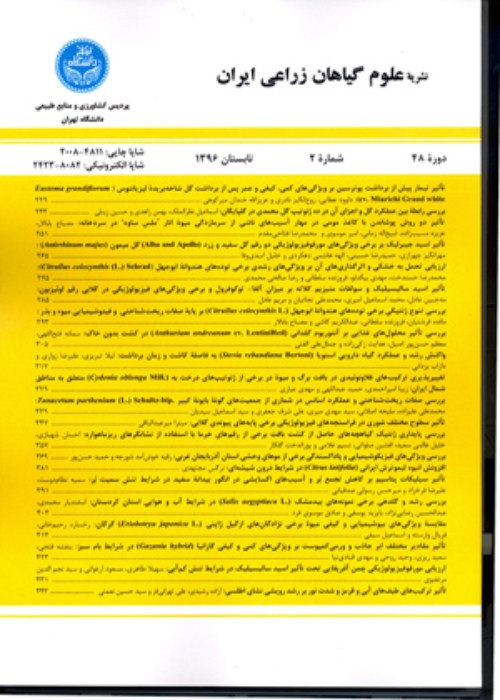Effects of Drought Stress and Re-Irrigation at the Flowering Stage on the Physiological and Biochemical Responses and Yield in Promising Lentil Lines
Author(s):
Article Type:
Research/Original Article (دارای رتبه معتبر)
Abstract:
Rapid and efficient recovery from water deficit stress may be one of the key determinants of drought adaptation in plants. The present study was designed to investigate drought stress tolerance and recovery in promising lentil lines at the flowering stage. For this, a factorial experiment based on the completely randomized design was conducted with three replications. The factors included 6 lentil lines, drought stress (control (irrigation at 80% FC or 20% moisture depletion), medium stress (irrigation at 55% FC or 45% moisture depletion), and severe stress (irrigation at 30% FC or 70% moisture depletion)), and three sampling times (three and six days after drought, and recovery (two days after re-irrigation)). Drought stress caused a decrease in chlorophyll a, chlorophyll b, total chlorophyll, carotenoid, protein, yield, and yield components. The reduction of these traits was more remarkable at six days after stress. However, during the recovery time remarkable increase was observed in these traits. The results showed that the correlation between H2O2 and MDA was significant and positive. Furthermore, drought stress increased the amount of proline, H2O2, and MDA, which resulted in an increase in the activity of antioxidant enzymes (catalase, polyphenol oxidase, and peroxidase). An increase in the intensity and duration of the drought stress also caused an increase in H2O2 and MDA content and the activity of antioxidant enzymes. In addition, in the recovery conditions, a significant reduction in the destructive effects of stress (H2O2, MDA content) and the activity of antioxidant enzymes was visible. The results of the present study indicated that the effects of drought stress on lentil lines yield and yield components (seed number, number of pods, 100-seed weight, and seed yield) were varied. Drought stress at the flowering stage decreased the number of seeds and pods per plant, and 100-seed weight, which led to yield losses. Although line 2 had the highest yield under normal and drought stress conditions, line 1 exhibited the lowest yield under stress conditions. Based on the results of this experiment, line 2 seems to be a suitable line for culture in the regions challenged with water deficit stress.
Keywords:
Language:
Persian
Published:
Iranian Journal of Field Crop Science, Volume:55 Issue: 1, 2024
Pages:
123 to 137
magiran.com/p2705452
دانلود و مطالعه متن این مقاله با یکی از روشهای زیر امکان پذیر است:
اشتراک شخصی
با عضویت و پرداخت آنلاین حق اشتراک یکساله به مبلغ 1,390,000ريال میتوانید 70 عنوان مطلب دانلود کنید!
اشتراک سازمانی
به کتابخانه دانشگاه یا محل کار خود پیشنهاد کنید تا اشتراک سازمانی این پایگاه را برای دسترسی نامحدود همه کاربران به متن مطالب تهیه نمایند!
توجه!
- حق عضویت دریافتی صرف حمایت از نشریات عضو و نگهداری، تکمیل و توسعه مگیران میشود.
- پرداخت حق اشتراک و دانلود مقالات اجازه بازنشر آن در سایر رسانههای چاپی و دیجیتال را به کاربر نمیدهد.
In order to view content subscription is required
Personal subscription
Subscribe magiran.com for 70 € euros via PayPal and download 70 articles during a year.
Organization subscription
Please contact us to subscribe your university or library for unlimited access!



